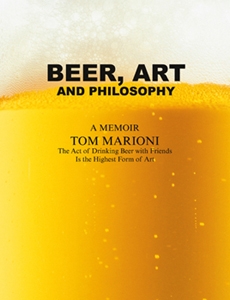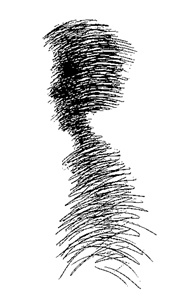Feature: Reviews
Marioni’s Memoir
Some Notes on Beer, Art, and Philosophy:
A Memoir by Tom Marioni
During the past decade there have been countless books published about Conceptual art and its genesis during the 1960s and 70s. This makes sense, because the primacy of ideas and meaning, which emerged in response to the material and perceptual focus of Minimalism, has been a central facet of art practice, theory, and criticism for the last thirty years.
However, with rare exceptions, the majority of historical accounts of the inception of Conceptual art practice have centered on New York, where language- and systems-based explorations prevailed. Few books have included the actions- and sculpture-based history of Conceptual art in the San Francisco Bay Area, and none have provided an artist’s autobiographical perspective on it. This accords Tom Marioni’s Beer, Art, and Philosophy: A Memoir special status as a first-hand account of the unique artistic milieu and events that fueled the evolution of Conceptual art in the Bay Area during the 1970s. Marioni’s narration of the experiences that contributed to the evolution of his art, ideas about social sculpture, and unique interpretation of his artistic forebears is conversational, engaging, and appropriately humorous, and his writing is rich in anecdote, opinion, and historical perspective. These qualities are made clear from the outset with the book’s subtitle, “The Act of Drinking Beer with Friends Is the Highest Form of Art.” He also provides a surprisingly intimate account of his life as a young man who came of age as an artist at the turn of the 1970s, in an art world still replete with possiblity.
The book opens with Marioni’s stories of his childhood in Cincinnati and experiences as an altarboy. As he describes the objects and rituals that are central to the Catholic Mass, he also reveals the ways in which this formed the visual, conceptual and performance foundation of his art. He explains that he has not tried to literally re-create the Mass, but his highly individual interpretation of it through the many facets of his art reveals the deep influence this ritual-filled experience had on his world view. As he describes it,“the candles, bells, bread, and wine, the gold chalice, the little safe, the candle snuffer—those were all objects that had power because they were used, they had a function, and they were sexually suggestive. I wanted to make objects with that kind of power, that’s why I became a sculptor.”
Of course, there were many other conditions Marioni describes that also influenced the development of his life and artistic vision—his early involvement with music, his family, art school, San Francisco, living in Europe—and it is fascinating how his experiences of these events and circumstances have been consistently colored by his perception of them through his perspective as an artist. Cases in point: custom cars (“sculpture that surrounds you”); how he became an artist in the army (“the army had no such category”); and the logic of his childhood connection to Duchamp through his wife Teeny, who was also from Cincinnati. Marioni’s stories about the artists and musicians who influenced the evolution of his thinking and art practice provide meaningful insight into his personal and artistic interpretation of the world. He writes of Miles Davis, who always played with his back to the audience; his own friendship with John Cage and the idea of ambient sound as the performed work in 4’33”; Duchamp’s Etant Donnes, which had bearing on Marioni’s Room for Interpretation with its keyhole viewing of a female torso and other elements.
For me, the most resonant facet of the book are Marioni’s stories from the late 1960s, which is when he became the curator at the Richmond Art Center (“My life changed. That’s when I moved into the real art world.”) It was during his tenure at the Richmond Art Center (from which he was fired for his highly provocative exhibitions) that he also created his most important social artwork, The Act of Drinking Beer with Friends is the Highest Form of Art (1970), working under the pseudonym of Allan Fish. This work was first exhibited at the Oakland Museum. During the 1970s he also invented the Museum of Conceptual Art, where he created many firsts, including the earliest Sound Art show, for which he performed Allan Fish’s Piss Piece; and Cafe Society, originally held at Breen’s bar where artists met each Wednesday to drink beer and talk. This became his ongoing social artwork, which over time has changed names and venues. After MOCA closed in 1984, he changed the name to Academy of MOCA, and later to Cafe Wednesday, and most recently, to the Society of Independent Artists (which meets in his studio), after the organization that exhibited Duchamp’s notorious urinal in 1917. It is no wonder that his uniquely codified belief system has influenced a younger generation of artists who are fixated on mining the fine line between art, life, and their social implications.
Marioni’s voice and writing style are simple and conversational, giving color to his pithy tales and sometimes less than laudatory remarks about San Francisco artworld protagonists. Throughout the narration of his life and development as an artist and thinker, he also makes stream of consciousness connections that are often non-linear, but never random. An example is his discussion of his brother Joe, who is a monochrome painter and is considered “a theorist of the monochrome paint movement.” As Marioni recounts, although Joe was not a good student, he could always beat their father at chess, which is an intellectual activity. As a next thought, Marioni talks about how John Cage and Marcel Duchamp used to play chess together. He describes how this activity frustrated Duchamp, because while he thought that “chess was sculpture created in your head,” and that “you have to construct your moves in your head before making them,” Cage played chess with Duchamp non-competitively, simply a means to spend time with him.
Marioni is also extremely pragmatic in his recognition of the cultural isolation of California (“like a separate country”); his assertion of its lack of literary tradition except for the Beat poets; and the West Coast influences from Asia and Europe, about which he states, “I am a product of that tradition.” Yet paradoxically, it is those same conditions, in climate, food-obsessed culture, and historically sketchy support for visual art, that have consistently fueled Marioni’s vision of unrestrained potential for his work and life as an artist.
Thomas McEvilley’s introduction to the book frames West Coast Conceptual art in relationship to the trends established in New York. In particular, he points out their differences, including the subtle humor that grew from John Baldessari’s works of the later 1960s, and the enthusiastic acceptance of such work in Europe this trait—and others—afforded artists like Marioni. The national and international context that McEvilley’s essay provides for Marioni’s work is valuable, especially the way in which he contextualizes Marioni’s primary themes as consistent with the major conceptual tendencies of the time (“negating crafts by preserving the art material as raw matter, negating intention by inviting the intervention of chance, and negating ego by unquestioningly accepting the result”).
One of the great pleasures of the book is the chance to consider McEvilley’s discussion of Marioni’s “firsts”—Marioni’s interpretation of Beuys’s “social sculpture” as the sacrament of drinking beer with friends; his creation of the Museum of Conceptual Art, which was the first alternative space in the country; his invention of drum brush drawings as a record of performance; and his approach to body drawings—and then to read Marioni’s own thoughts about his inventive approaches to the act of creating art. This is reinforced with the line drawings of his own and other artists’ work that Marioni created to illustrate the book, which request our renewed consideration and enjoyment of the works.
It is especially meaningful to consider McEvilley’s suggestion that Marioni’s memoir is “the newest of his social artworks, a work that consists of the author’s relationship with you, the readers, not unlike the conversation of friends drinking beer together.” But it is Marioni who deserves the last word here, as his views on and analysis of Conceptual art and its origins are critical. He is philosophical (this book is, after all, about beer, art and philosophy), acknowledging that his ideas were new thirty years ago while expressing the hope that “the next art will have its own presence.” He epitomizes his world view by quoting George Carlin’s belief that “The job of the comedian is to find where the line is drawn, deliberately cross it, and make the audience glad you took them with you,” and equates it with his own belief that, “I would say that’s the job of all artists.”
All images by Tom Marioni.




Tom named his youngest boy after Miles Davis. Miles Marioni is a great artist too but has yet to be discovered. His oldest boy Reno is a computer whiz and his 2nd child Tony is a very successful accountant. Their mother Marilyn died 10 years ago in a small plane crash.
A friend of his boys • December 10, 2007